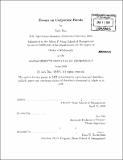| dc.contributor.advisor | Jun Pan. | en_US |
| dc.contributor.author | Bao, Jack (Jack C.) | en_US |
| dc.contributor.other | Sloan School of Management. | en_US |
| dc.date.accessioned | 2010-08-31T16:16:58Z | |
| dc.date.available | 2010-08-31T16:16:58Z | |
| dc.date.copyright | 2009 | en_US |
| dc.date.issued | 2009 | en_US |
| dc.identifier.uri | http://hdl.handle.net/1721.1/57870 | |
| dc.description | Thesis (Ph. D.)--Massachusetts Institute of Technology, Sloan School of Management, 2009. | en_US |
| dc.description | Cataloged from PDF version of thesis. | en_US |
| dc.description | Includes bibliographical references (p. 147-151). | en_US |
| dc.description.abstract | This thesis consists of three empirical essays on corporate bonds, examining the role of both credit risk and liquidity. In the first chapter, I test the ability of structural models of default to price corporate bonds in the cross-section. I find that the Black-Cox model can explain 45% of the cross-sectional variation in yield spreads. The unexplained portion is correlated with proxies for credit risk and thus, cannot be attributed solely to non-credit components such as liquidity. I then calibrate a .jump diffusion model and a stochastic volatility model, finding that the jump diffusion model weakly improves cross-sectional explanatory power while the stochastic volatility model does not. However, much of the cross-sectional variation in yield spreads remains unexplained by structural models. In the second chapter (co-authored with Jun Pan), we examine the connection between corporate bonds, equities, and Treasury bonds through a Merton model with stochastic interest rates. We construct empirical measures of bond volatility using bond returns over daily, weekly, and monthly horizons. The empirical bond volatility is significantly larger than model-implied volatility, particularly when daily returns are used, suggesting liquidity as an explanation. Indeed, we find that variables known to be linked to bond liquidity are related to excess volatility in the cross-section. Finally, controlling for equity and Treasury exposures, we find a systematic component in bond residuals that gives rise to the excess volatility. | en_US |
| dc.description.abstract | (cont.) In the third chapter (co-authored with Jun Pan and Jiang Wang), we examine the liquidity of corporate bonds and its asset-pricing implications. Our measure of illiquidity is based on the magnitude of transitory price movements. Using transaction-level data, we find the illiquidity in corporate bonds to be significant, substantially greater than what can be explained by the bid-ask bounce, and closely related to bond characteristics. We also find a strong commonality in the time variation of bond illiquidity, which rises sharply during market crises. Monthly changes in aggregate bond illiquidity are strongly related to changes in the CBOE VIX index. Finally, we find a relation between our measure of bond illiquidity and the cross-sectional variation in bond yield spreads. | en_US |
| dc.description.statementofresponsibility | by Jack Bao. | en_US |
| dc.format.extent | 151 p. | en_US |
| dc.language.iso | eng | en_US |
| dc.publisher | Massachusetts Institute of Technology | en_US |
| dc.rights | M.I.T. theses are protected by
copyright. They may be viewed from this source for any purpose, but
reproduction or distribution in any format is prohibited without written
permission. See provided URL for inquiries about permission. | en_US |
| dc.rights.uri | http://dspace.mit.edu/handle/1721.1/7582 | en_US |
| dc.subject | Sloan School of Management. | en_US |
| dc.title | Essays on corporate bonds | en_US |
| dc.type | Thesis | en_US |
| dc.description.degree | Ph.D. | en_US |
| dc.contributor.department | Sloan School of Management | |
| dc.identifier.oclc | 624173602 | en_US |
